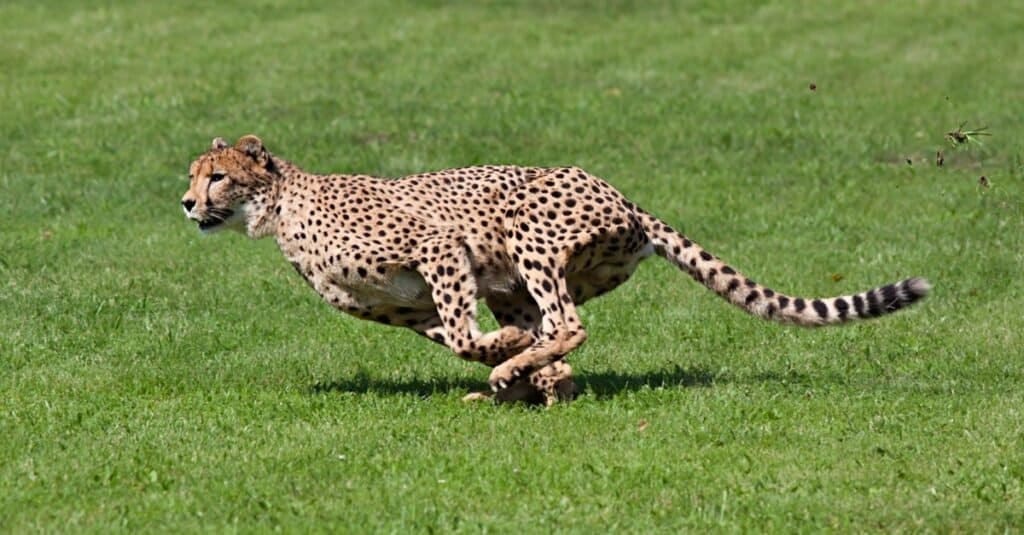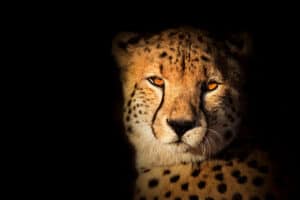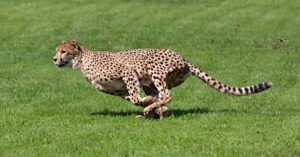If there were the Olympics of the animal kingdom, the cheetah would be Usain Bolt. The cheetah is a lightning predator, able to go from zero to 60 miles per hour in three seconds. In fact, cheetahs can reach speeds up to 60 to 75 miles per hour, though not for long. Cheetahs can only run at top speed for 30 seconds before needing to rest. But this speedy carnivore can do a lot of damage in 30 seconds.

Cheetah hunting springbuck at top speed in Etosha National Park.
©Elana Erasmus/Shutterstock.com
Why Can’t Cheetahs Run at Top Speed for Long?
For a long time, scientists believed that cheetahs overheat when running. Once their bodies reach a certain temperature, they must rest to bring down their internal heat. This idea was based on an experiment that two Harvard scientists conducted in 1973. These two scientists took two cheetahs who had been raised in captivity, had the cheetahs run on treadmills, and then recorded their temperatures. Based on the readings, the scientists determined that cheetahs couldn’t lose heat quickly enough while zipping around at top speeds. That is why they couldn’t sprint for long: they needed to cool down.
The problem is that the scientists were measuring the speeds of domesticated cheetahs, not wild ones. Unlike those born on the savanna, these cheetahs barely had opportunities to run. As a result, these poor cheetahs only reached speeds of 19 miles per hour for 1.24 miles, whereas wild cheetahs run 60 miles an hour for just a few hundred meters. It became common knowledge from that experiment that cheetahs can run at top speed for only a little bit before abandoning the hunt to cool down. But this myth was finally debunked.
Robyn Hetem, a researcher from the University of Witwatersrand in South Africa, started studying wild cheetahs when they hunt. Hetem and her team took six cheetahs and implanted two sensors: one in their hips to measure movement and another in their stomachs to record the temperature. They found that a cheetah’s body temperature fluctuates between 99.1°F to 103.1°F. And what’s more surprising, the cheetahs didn’t get any hotter when running. The average body temperature of a cheetah after a hunt was 101.1°F. So, body temperature did not determine how long cheetahs can run at top speed.
You can read more about Robyn Hetem’s research and conclusions here.
How Do Cheetahs Run so Fast?
Even though we still don’t know why cheetahs will give up on a hunt, even when reaching top speeds, we do know how they do it.
The cheetah’s body is very lean and light. They have a flattened rib cage and a small head. These features reduce air resistance and give these cats powerful drag force. The incredible gait of a cheetah means that a cheetah’s paws spend more time in the air than pushing off the ground. Therefore, when a cheetah runs, its feet touch the surface one at a time. The cheetah’s gripping paw pads and non-retractable claws entail incredible traction on the terrain. Also, the cheetah’s long, ropy tail serves as a counterbalance and rudder. Without its tail for balance, the cheetah would hardly be able to maneuver and would crash as it runs at top speeds.
Not only that, the cheetah’s spine is incredibly flexible. The spine rapidly expands and contracts, allowing the cheetah’s legs to reach even further. Also, a cheetah’s shoulder blades aren’t connected to the collarbone. Thus, cheetahs can super-extend their legs and lengthen their bodies to cover more distance per stride.
Cheetahs also sport oversized hearts and lungs. Their large heart can pump massive amounts of blood to the muscles. The heart is also very strong, so it can easily adapt from resting mode to flat-out sprinting. Then, the lungs take in huge volumes of oxygen with one breath. At that point, the heart pumps the oxygen to the muscles, and the lungs quickly dispose of the carbon dioxide. This rapid system is necessary for the strength it takes to sprint at high speeds.

Cheetahs are the planet’s fastest land animal is built for super speed, rather than stamina.
©Maros Bauer/Shutterstock.com
How Do Cheetahs Hunt?
The first step for cheetahs is to get as close as possible to their prey. The cheetah’s camouflage is quite impressive, and as it hunches below the grass line, its lean body is barely visible. A cheetah will prowl as close as it can get, but camouflage can only go so far with such open plains on the savanna. Once the grass covers thins out, it is down to running.
A cheetah bursts out, going from zero to 60 miles per hour in three seconds. How does its prey ever survive such speeds? The prey runs in zigzags! Again, this is where the cheetah’s perfect tail comes in, helping it to maneuver and adjust. The cheetah swipes at its victim as soon as it gets close, causing its prey to trip. Once its prey hits the dirt, the cheetah pounces. The cheetah’s strong, vice-like jaw clamps down on the windpipe until the prey dies.
Then, the countdown clock begins. The cheetah is built for speed, but it is a weak fighter. If the cheetah doesn’t devour its kill, lions, leopards, and even hyenas will chase it off.
So, what do cheetahs like to eat? These meat-loving cats eat small antelope, impalas, and gazelles. They will also go after the young of larger beasts such as warthogs, kudu, and sable. But cheetahs are also known to eat small game, such as rabbits and birds.
Even though half a minute is only how long cheetahs can run at top speed, they don’t need much time. When you chase down prey at 75 miles an hour, there is a good chance you will catch what you came for! That’s why this incredible creature wins gold for speed!
The photo featured at the top of this post is © Marcel Brekelmans/Shutterstock.com
Thank you for reading! Have some feedback for us? Contact the AZ Animals editorial team.






